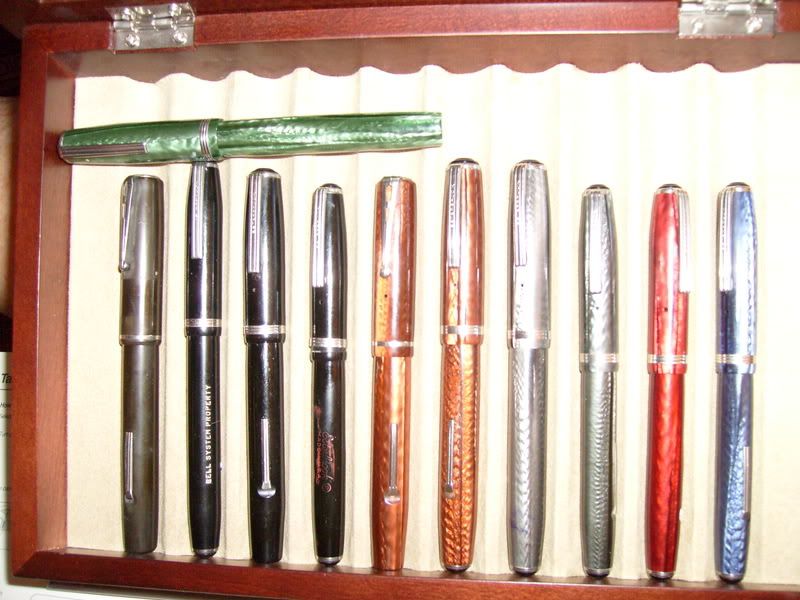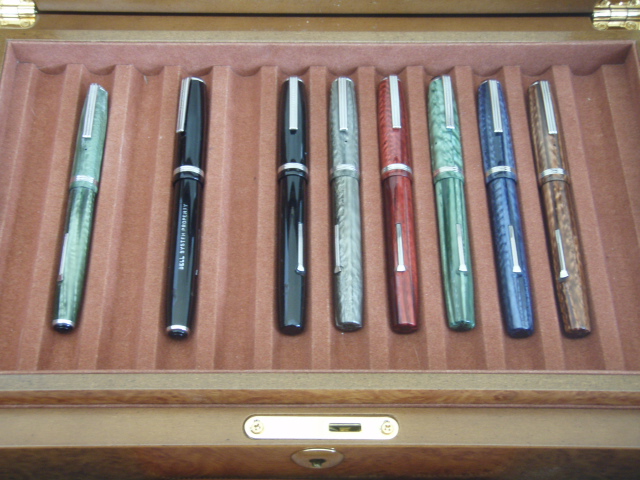- Messages
- 11,579
- Location
- Covina, Califonia 91722
Since the LA Pen Show 2/15/09 where Shellie picked up a couple of Esterbrooks I have been revisiting some of mine and have 4 of them inked. A silver LJ, a black Bell System LJ, a black SJ and a copper colored Dollar pen.
I popped out the nibs on them so they have 3 of the #9668 General Writing Mediums and one 2668 General Writing Medium.
As mentioned here and in other fountain pen threads, the Esterbrooks featured a replaceable nib feed unit that screws in and out easily. This feature allows one to replace a ruined nib or change to a different style of writing quickly and easily. Esterbrook started as a steel nib manufacturer for DIP pens and when they jumped to fountain pens they made this system to allow for a multitude of choices of nib styles that is greater than any manufacturer today. (Go and see the nib chart at the website listed below for the big list!)
The replaceable nib feed units are refered to as "Renew Points" and there were 3 feed designs described as thin flat, medium flat, and round styles. There are photos or drawings on line showing the change going early to late.
There are five series of Renew Point that were available. These fountain pen nibs have a four digit number to indicate what type of nib it is and there are charts that describe the different points by the writing style.
The 1000 and 2000 series were marketed as DuraCrome Points and are all steel including the tip the little ball on the front that is the shaped writing surface. They do not have a hardened material like "Iridium" for the point. While not as long lasting as the iridium type, they write really remarkably well but this is beause of the Esterbrook experience in making nibs even before there were fountain pens.
The 3000 series are known as sunburst style and use Osmiridium as the tipping ball. I think the sunburst comes from the orange box they came in. They are pretty rare to find.
The 8000 series is similar to the 3000 and used a palladium alloy as the tipping material and were made during WWII. These are very rare to find.
The 5000 series are for the Dip-Less desk pens which are actually dip pens not fountain pens.
Finally the 9000 series are their top of the line Renew Point nibs and were marketed as Master Point nibs made with an iridium tip. They cost significantly more than the 1000 & 2000.
Here is a really good chart from the Snyder Family, their comments follow what the experts say and I have included the jist of them above.
http://www.snyderfamily.com/current/estienibs.htm
This chart is the one they had on the top of the storage box, it has a sample of writing with the description too. Unfortunately it's a little hard to make out. I copied it as a photo and have an enlargement in my photos someplace.
http://www.vintagepens.com/esterbrook_nib_chart.shtml
So if you are of the type that doesn't believe a steel nib can be a good writer you should try an Esterbrook with a 1000, 2000 or 9000 series nib that is in good condition, they are really great to use.
I popped out the nibs on them so they have 3 of the #9668 General Writing Mediums and one 2668 General Writing Medium.
As mentioned here and in other fountain pen threads, the Esterbrooks featured a replaceable nib feed unit that screws in and out easily. This feature allows one to replace a ruined nib or change to a different style of writing quickly and easily. Esterbrook started as a steel nib manufacturer for DIP pens and when they jumped to fountain pens they made this system to allow for a multitude of choices of nib styles that is greater than any manufacturer today. (Go and see the nib chart at the website listed below for the big list!)
The replaceable nib feed units are refered to as "Renew Points" and there were 3 feed designs described as thin flat, medium flat, and round styles. There are photos or drawings on line showing the change going early to late.
There are five series of Renew Point that were available. These fountain pen nibs have a four digit number to indicate what type of nib it is and there are charts that describe the different points by the writing style.
The 1000 and 2000 series were marketed as DuraCrome Points and are all steel including the tip the little ball on the front that is the shaped writing surface. They do not have a hardened material like "Iridium" for the point. While not as long lasting as the iridium type, they write really remarkably well but this is beause of the Esterbrook experience in making nibs even before there were fountain pens.
The 3000 series are known as sunburst style and use Osmiridium as the tipping ball. I think the sunburst comes from the orange box they came in. They are pretty rare to find.
The 8000 series is similar to the 3000 and used a palladium alloy as the tipping material and were made during WWII. These are very rare to find.
The 5000 series are for the Dip-Less desk pens which are actually dip pens not fountain pens.
Finally the 9000 series are their top of the line Renew Point nibs and were marketed as Master Point nibs made with an iridium tip. They cost significantly more than the 1000 & 2000.
Here is a really good chart from the Snyder Family, their comments follow what the experts say and I have included the jist of them above.
http://www.snyderfamily.com/current/estienibs.htm
This chart is the one they had on the top of the storage box, it has a sample of writing with the description too. Unfortunately it's a little hard to make out. I copied it as a photo and have an enlargement in my photos someplace.
http://www.vintagepens.com/esterbrook_nib_chart.shtml
So if you are of the type that doesn't believe a steel nib can be a good writer you should try an Esterbrook with a 1000, 2000 or 9000 series nib that is in good condition, they are really great to use.





